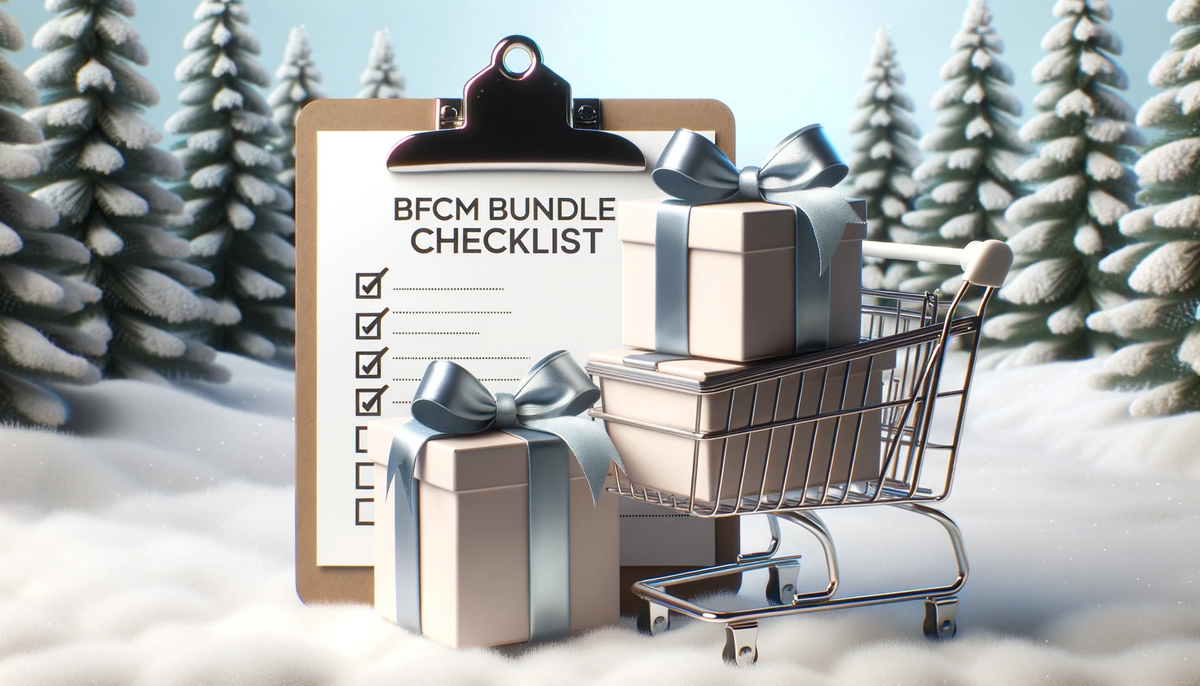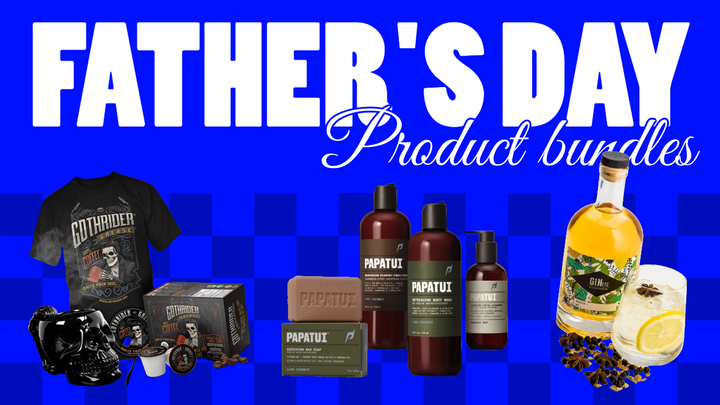Mastering BFCM Bundles: Your Guide to Boosting Holiday Sales
During the holidays, brands have a unique opportunity to create bundles that boost the Average Order Value (AOV) and cultivate long-term customer loyalty.

Product bundling isn’t just about offering discounts—it’s about crafting an unparalleled experience for your customers.
For the Black Friday/Cyber Monday season, brands have a unique opportunity to create bundles that boost the Average Order Value (AOV) and cultivate long-term customer loyalty.
Take it from Nate Lagos, Head of Marketing at Original Grain and Growth Consultant for DTC Brands:
“One thing that I like about bundling is that cohorts of customers that come in on the bundle have a significantly higher LTV because it’s a different customer mentality. They’re not just looking to spend the least amount of money possible—they’re looking to get the best value. So if you create a bundle that combines a higher cost but a much higher perceived value for the customer, that customer will have a lot better LTV going forward than someone who just bought on a straight discount.”
In other words, with a focus on maximizing the average order value and understanding the unique psychology behind bundled purchases, bundles can be a strategic asset to converting more high-LTV customers this holiday season.
This checklist will navigate you through the art and science of creating bundles that enhance your revenue and elevate your customers’ perception of value.
1. Strategically curate bundles for your store
When maximizing your BFCM/Holiday bundle sales, a strategic approach to curating your bundles can make all the difference. Here are five checklist items:
Analyze Shopify online store cart report
First things first, analyze your Shopify Online store cart analysis report for the past 30 days. This invaluable resource can unveil precious insights into your customers' shopping behaviors.
Keep an eye out for products that are consistently added to the same cart. If these products are purchased together 5-10% of the time, you're onto something. Customers already indicate their preferences, and bundling these items together could provide added value.

Consider seasonal trends
Staying attuned to seasonal trends is essential—especially for curating bundles that customers won't resist.
Consider the nature of your products and how they align with different seasons. For instance, if your store specializes in skincare products, consider what your customers need during various seasons. A sunscreen and after-sun lotion might be perfect for summer, ensuring your customers are protected from the sun and cared for after exposure. Similarly, you might bundle moisturizers and lip balms in winter to combat dry skin caused by cold weather.
Here’s an example from Tubby Todd:
Tip: Don't limit yourself to the immediate past (like the last 30 days) when researching seasonal trends. Instead, look at data from the same period in previous years to identify consistent patterns. Trends tend to repeat, and understanding historical data can give valuable insights into what customers will likely seek during specific seasons.
Leverage consumer feedback and social listening
Your customers are your best resource for understanding their needs and preferences. Don't hesitate to reach out to them directly. Consider conducting surveys or directly asking for feedback on potential bundles.
You can use email newsletters or pop-ups on your website to encourage participation or leverage social media polls for a more interactive option. Their responses can provide a clear picture of what they expect from your bundles and what products they’re interested in.
For a less direct solution, try either
- keeping a close eye on social media conversations and product reviews. Customers often spontaneously share their product pairings or wish lists online. By monitoring these conversations, you can identify popular product combinations.
- Unveiling potential products on Instagram posts or stories. You can observe which designs resonate most with your audience based on likes and shares. This preemptive testing, done before stocking items, allows you to identify the most popular options.
Example: Brands can take a chapter from the video game industry for this. Businesses like XBOX and PlayStation always know which games their shoppers are anticipating. To prepare for these launches, they release limited-edition console bundles. These feature a beautifully designed console version, the video game itself, and exclusive online downloadable items.
These releases always see a lot of hype from the gamer community.
Be strategic about stock
If you find yourself with excess inventory, there’s a smart way to turn this situation around and make the most of the increased traffic during the holiday season.
BFCM is the perfect opportunity to pair these surplus items with other popular products in a bundle. But here's the key: it has to make sense. Think about items that complement each other or can be used together.
For instance, if you have excess phone cases, consider bundling them with screen protectors or portable chargers. Bundles need to feel cohesive and valuable to the customer.
Tip: Create a sense of urgency around your excess stock by offering special deals for a limited quantity. And make it clear to your customers that they are getting a fantastic deal by purchasing the bundle, especially considering the discounted price and the additional items included.
Align pricing with AOV and margins
Pricing your bundles strategically is not just about setting numbers; it’s about finding the sweet spot where your customers are happy with their purchase and you, as a business, maintain healthy margins.
Nate’s advice provides a valuable perspective on how to approach pricing for your BFCM/Holiday bundles:
“Make sure your bundle ends up being priced higher than your AOV, and I like to go significantly higher—if you can 20-30% higher than your AOV is a really good target to shoot for. Make sure your margins are good on that bundle, of course. And make it the best deal possible for your customer,” he said.
2. Bundle inventory management
Bundle inventory management involves a meticulous approach to organizing, tracking, and optimizing your bundled products to meet customer demand while ensuring seamless operations. Make sure you’re doing the following:
Coordinate with your suppliers
The holiday season is the perfect time to introduce limited-edition bundles with unique designs. But you don’t want to create these offers at the expense of your shipping experience.
Speed and accuracy are still essential, so here’s what you should start planning for now:
- Packaging requirements: Consider whether your bundle packaging requires different shipping boxes or materials. Some bundles might be bulkier or more fragile, necessitating special attention to packaging.
- Bundle-specific packaging and labeling: Unique packaging can elevate the perceived value of your bundles, making them more attractive to customers. These small details can make a significant impact, whether it's festive wrapping, custom boxes, or themed labels. Coordinate these details now with suppliers so they’re prepared ahead of time.
Following these best practices ensures your bundles look enticing and are packaged and delivered seamlessly.
Ensure adequate stock levels and forecast potential stockouts
Insufficient stock levels can lead to missed sales opportunities and dissatisfied customers. You have to strike the right balance between individual product sales and bundled sales.
In other words, ensure that you have enough stock to cater to the demand for each product in your bundles, as well as on their own.
Here are two tasks you should start now before the busy holiday season:
- Monitor the popularity of your bundles in real time and analyze customer behavior to identify trends. If a particular bundle is gaining traction, anticipate potential stockouts by ramping up production or securing additional inventory for the included products.
- Implement inventory management tools that provide accurate and up-to-date information on your stock levels. Set up alerts for low stock to receive notifications when inventory reaches a predetermined threshold.
Being proactive in managing popular bundles can prevent stockouts and guarantee you can fulfill customer orders promptly.
3. Marketing and promotions of bundles
Creating a buzz around your bundles is as important as the bundles themselves. Let’s talk about how to do this:
Use strategic copywriting
The words you use can be the difference between a customer making a purchase and scrolling past. Consider these five tips:
- Identify the unique selling points. Emphasize these points in your copy. Clearly communicate what sets each bundle apart, whether it’s significant savings, exclusive products, or a limited-time offer.
- Weave a narrative around your bundles. Tell a story about how the bundled products can solve a problem, enhance a lifestyle, or bring joy during the holiday season.
- Focus on clarity. While creativity is essential, clarity should never be compromised. Use clear and concise language in your bundle descriptions. Avoid jargon and complex sentences that might confuse potential buyers.
- Optimize for mobile. Ensure your bundle descriptions are concise and engaging, even on smaller screens. Use short paragraphs, bullet points, and compelling headers to break up the text.
- Name your bundles. Choosing the right names for your bundles is more important than you think. An effective bundle name not only communicates the essence of the products but also captures the attention of potential buyers.
“Always name your bundles. For example, I worked with Lalo's BFCM bundles last year and named them things like the ‘Ultimate Family Starter Bundle,’ ‘Messy Mealtime Bundle,’ and ‘Booster + Big Bites Starter Kit.’ It can be cutesy (but on brand) or purely ‘Product 1 + Product 2 Bundle’. Essentially, make it easy for the shopper to envision it as a gift or for a use case.”
- Maria West, Head of Marketing & Partnerships at Voyage SMS & LiveRecover
Craft bundle-specific campaigns
Of course, you want to strategically choose bundle campaigns, such as BOGO deals, free gifts, or curated bundles. Plus, design eye-catching visuals and graphics to highlight the bundled products and the benefits of purchasing them together.
However, there’s more to it than choosing the bundle type and pushing it live on your product pages. You need to grab customers' attentionCommunicate and showcase the value of your bundles.
According to Nate Lagos, this is a challenge every brand must be prepared to face.
“When you’re advertising bundles ahead of Black Friday, you need to understand that you’re competing against so many other ads in everyone’s news feed—ads that are likely going to say anywhere between 30-50% off and maybe some BOGO deals as well,” he said. “Consumers are going to be a lot more price-conscious than we’ve seen previously. So make sure that your bundle is actually a great offer for the customer and that the perceived value is as high as possible.”
A few tips:
- Create urgency by highlighting the time-limited offer for your bundle campaigns.
- Communicate the financial benefits to your customers. Show them the total value of the products included in the bundle versus the bundled price, emphasizing the savings they'll enjoy.
- Add testimonials from satisfied customers who saved significantly by purchasing bundles to add social proof to PDPs.
LALO features all testimonials on product bundle landing pages, like in the example below.
Integrate bundles into your email and SMS flows
During the holidays, devote specific email campaigns to showcase your bundle deals and find natural ways to call out your bundles in your current flows.
For example, if a customer adds an eyeshadow pallet to their cart and abandons it, and you have a bundle that includes that pallet as well as eyeshadow brushes, make sure to call out the bundle as an upsell in the abandoned cart email flow—not just the individual product.
This reminds the customer about the product they were viewing and gives you a chance to showcase an even more valuable offer that could incentivize the customer enough to convert.
Take these campaigns even further by…
Segmenting customers to personalize your promotions
Segment your customer base using criteria such as purchase history, duration as a customer, and previous interactions with your bundles. Leverage this segmentation to tailor personalized bundle promotions for each segment.
For example, you may want to introduce new customers to your most popular bundles. And for loyal customers, offer exclusive bundles or loyalty rewards as a token of appreciation.
Incorporating SMS segmentation
According to Maria West, “First-time buyers come out to play during BFCM, and many need a boost they can't ignore (AKA extra discount) to get them over the finish line.”
One effective strategy to capture customer attention during BFCM is incorporating SMS into your abandoned cart strategy. Compared to flooded email inboxes, text messages have an average 98% open rate and a 9.18% click-through rate, making them a great alternative for reaching customers.
“You can even do this without a whole opt-in sequence using P2P messaging as long as the shopper includes their phone number in the checkout,” Maria says.
By using SMS, you can strike while the iron is hot and increase sales by offering higher AOV bundles. But since SMS messages are read quickly, use clear and compelling language to grab attention.

Highlight top-selling bundles
Store data and analytics from platforms like Shopify provide invaluable insights into customer behavior and preferences. Exploring Shopify’s “Analytics” can help you identify your most popular products, successful traffic sources, and average order value (AOV).
Understanding these metrics lets you pinpoint your top-selling bundles and recognize customer purchasing patterns.
For instance, if your data shows that customers frequently purchase two specific items together, bundle these items at a slightly discounted price. Alternatively, offer a compelling discount on a third complementary item when customers buy the two popular items together. This strategy increases the AOV and provides customers with additional value, encouraging them to make larger purchases.
Once you’ve identified your top-selling bundles, prominently feature them on your website and in your marketing materials. Creating dedicated bundle landing pages, banners, product carousels, or homepage sections showcasing these bundles.
Here's an example we love from Olipop:
Continue reading: Designing high-converting product bundle landing pages
Prep your customer support team
Your customer support team plays a pivotal role during the BFCM/Holiday sales period—and a well-informed team can turn your support channel into a revenue engine.
Customer support should be able to answer customer queries confidently and promote the benefits of choosing bundles over individual items. To achieve this, you need to
- Provide comprehensive training to your customer support team about each bundle and its contents. Familiarize them with unique selling points, limited-time offers, or exclusive items within the bundles.
- Prepare support materials such as FAQs, product guides, and comparison charts that outline the advantages of purchasing bundles.
- Empower your customer support team to proactively recommend relevant bundles to customers, especially during pre-sales support. Train them to understand customer needs and preferences, allowing them to suggest bundles that align with the customer’s requirements.
Your customer support team’s expertise, coupled with effective communication and promotion of bundle benefits, can significantly influence purchasing decisions.
5. Shipping and fulfillment of bundles
The fulfillment side of product bundles is spoken about less than curating and marketing, yet it’s equally important.
The goal? Enhance the accuracy and speed of processing bundle orders to get products into the hands of customers quickly during the holiday season. Here’s what to focus on:
Coordinate with your fulfillment team
A well-organized fulfillment process contributes to positive customer experiences, reinforcing their trust in your brand and encouraging repeat purchases.
So what should you do? Clearly define how your fulfillment team should receive order information that contains bundles by
- Providing detailed instructions on identifying bundled orders, including specific product names and quantities.
- Ensuring your fulfillment team knows the bundle configurations and any special packaging requirements is essential.
👉A bundles app can streamline your entire fulfillment process
Simple Bundles is designed to break out individual line items in your bundle SKU with additional options to offer flexibility depending on how your fulfillment center prefers to receive bundle details. This gives fulfillment teams a clear and accurate overview of the items included in each bundle.
Continue reading: The benefits of streamlined shipping for product bundling
Allow for single-item returns from the bundle
A key aspect of customer satisfaction in the world of bundled sales is flexibility, especially when it comes to returns. In fact, 92% of consumers said they would buy again if a brand’s return process were easy.
Here’s where bundles get tricky, though: customers might occasionally wish to return a single item from the bundle—versus the entire bundle.
You can imagine how this can become a logistics mess. But on the other hand, allowing single-item returns demonstrates your commitment to excellent customer service.
This is why Simple Bundles has built-in functionality for making bundle returns easy to manage. Customers can create a return to an Order if the Order has at least one fulfilled line item that has not been refunded.
How this works: Under the “return items” tab, you can simply select the line items for the items that are being returned and select a reason for the return. Once you add a tracking number, you can click “create return.” Easy.
Tip: Offer the customer store credit or an exchange as an alternative to refunds for individual items within a bundle. This can encourage customers to make another purchase, maintaining their loyalty and sales.
Build your bundles before the holiday traffic uptick
As the holiday season approaches and the surge in online shopping is on the horizon, now is the best time to set up your product bundles.
Simple Bundles offers a streamlined approach to bundle inventory management, enabling businesses to coordinate with suppliers effectively, enhance shipping and fulfillment processes, and offer exceptional customer support.
The result? A seamless shopping experience that not only meets but exceeds customer expectations, fostering brand loyalty and encouraging repeat purchases.
Try Simple Bundles for free here.


